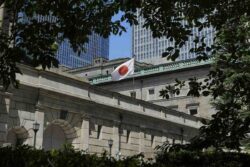Shift in Monetary Easing Policy: Conditions Created for Virtuous Economic Cycle / Watch Impact of Interest Rate Increases Closely
15:35 JST, March 20, 2024
The Bank of Japan’s approximately 11-year-old policy of massive monetary easing has reached a major turning point. It is important to accurately judge changes in the Japanese economy and manage monetary policy.
The central bank decided to end its negative interest rate policy at its monetary policy meeting on March 19.
High prices with wage increases
The Bank of Japan has so far applied a minus 0.1% interest rate to some of the funds deposited by banks and other financial institutions in their current accounts at the central bank, and pushed down short-term interest rates in the market. However, the bank will end this policy and raise the policy interest rate to around 0% to 0.1%.
This is the central bank’s first interest rate increase in about 17 years, since February 2007.
The bank has also abolished its yield curve control (YCC) framework, which had guided the short-term interest rate to minus 0.1% and capped the 10-year government bond yield at around 0%.
Many of the bank’s massive monetary easing measures will now come to an end.
The Japanese economy has suffered from deflation for many years, but recently the situation has changed as prices are rising. Given the state of the economy and prices, a shift in monetary easing is appropriate.
On the other hand, the central bank said it will continue to purchase around ¥6 trillion worth of long-term Japanese government bonds per month and will not rush to raise interest rates further. It intends to maintain a certain degree of monetary easing. This probably indicates a policy of raising interest rates with caution so that sudden policy changes do not cool the economy.
Bank of Japan Gov. Kazuo Ueda, who took office in April 2023, had maintained monetary easing, saying that high prices had not been accompanied by sufficient wage increases. However, Japanese companies offered to raise wages by an average of 5.28% in this year’s shunto spring wage negotiations, far larger than the previous year’s figure, according to a first tally by the Japanese Trade Union Confederation (Rengo). It is the first time in 33 years that the average has exceeded 5%.
The consumer price index rose at a rate of 2% or more for 22 consecutive months through January this year. The reason for this increase has shifted from a sharp rise in energy and other import prices to a rise in service prices, which respond quickly to wage increases.
At the press conference on the day, Ueda said that “it came in sight that the price stability target of 2% would be achieved in a sustainable and stable manner.” The central bank’s decision can also be said to indicate that conditions have been created for a virtuous economic cycle in which rising prices and wages lead to growth.
Under former BOJ Gov. Haruhiko Kuroda, who took office in the spring of 2013, the central bank initiated an extraordinary monetary easing policy in which it purchased a large amount of Japanese government bonds. As a result, the excessive appreciation of the yen was corrected, and improved corporate earnings led to higher stock prices.
The monetary easing policy can be praised for having brought a certain degree of stability to the Japanese economy.
On the other hand, the initial target of achieving 2% inflation in around two years could not be achieved, and monetary easing became prolonged, leading to such measures as the negative interest rate policy and YCC being introduced in quick succession in 2016.
Side effects of prolonged monetary easing
The prolonged implementation of these measures has brought side effects to the fore. In addition to the deterioration of financial institutions’ earnings due to ultra-low interest rates, the central bank’s purchase of a large amount of Japanese government bonds led to a dysfunctional government bond market.
Recently, some have voiced criticism that, due to continued monetary easing, the interest rate gap has widened between Japan and the United States, which has been raising interest rates, and this gap has led to a weaker yen and higher prices.
The central bank’s decision this time may be aimed at containing side effects and returning its monetary policies back to a normal form.
However, the transition to a “world with interest rates” after the end of negative interest rates has some downsides for the economy. There is a fear that interest rates on mortgages and corporate borrowing could rise, and that the interest rate burden on households and small and midsize businesses could increase.
Financial institutions should thoroughly explain the risks of rising interest rates to their customers.
The outlook for financial markets is also unpredictable. While the Bank of Japan is raising interest rates, the U.S. Federal Reserve Board is strongly expected to cut rates as early as the second half of this year.
If speculation spreads that the interest rate gap between Japan and the United States will narrow, the yen could rapidly appreciate in exchange markets. There is also concern that this could depress Japan’s bullish stock market, in which the Nikkei Stock Average has climbed above 40,000.
The central bank needs to remain vigilant to prevent confusion in the financial markets.
Urgent need to restore fiscal health
If interest rates rise, it will affect the nation’s fiscal management. This is because an increase in the costs of interest payments on government bonds will be inevitable.
The central bank’s monetary easing has kept interest payment costs low, which has loosened the nation’s fiscal discipline. This is pointed out one of the side effects of the easing measures. The government significantly increased its spending to handle the coronavirus pandemic, and Japan’s national debt, including government bonds, ballooned to ¥1.27 quadrillion at the end of fiscal 2022.
Due to the rise in long-term interest rates, funds to be used mainly for interest payments on government bonds have already hit a record high in the initial budget plan for fiscal 2024. The government must keep firmly in mind that fiscal soundness has become more important than ever.
(From The Yomiuri Shimbun, March 20, 2024)
"Editorial & Columns" POPULAR ARTICLE
-

Violations of Subcontract Law: Major Automakers Must Eliminate Old Practices
-

Local Governments’ Tax Revenues: Devise Ways to Correct Imbalances in Tax Sources
-

Heavy Rains in Asia: Support for Victims, Flood-Control Measures Urgently Needed
-

5 Japanese Business Dinner Mistakes to Avoid — and What They Taught Me About Business in Japan
-

New Nuclear Threat: China Seeking to Follow U.S., Russia in Military Expansion
JN ACCESS RANKING
-

Keidanren Chairman Yoshinobu Tsutsui Visits Kashiwazaki-Kariwa Nuclear Power Plant; Inspects New Emergency Safety System
-

Imports of Rare Earths from China Facing Delays, May Be Caused by Deterioration of Japan-China Relations
-

University of Tokyo Professor Discusses Japanese Economic Security in Interview Ahead of Forum
-

Japan Pulls out of Vietnam Nuclear Project, Complicating Hanoi’s Power Plans
-

Govt Aims to Expand NISA Program Lineup, Abolish Age Restriction




















